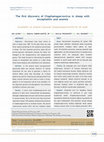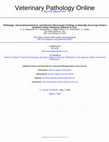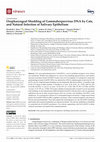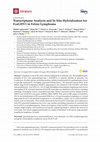Papers by Patricia Pesavento

Archives of Virology, Jun 4, 2015
We characterized the genome of a highly divergent gyrovirus (GyV8) in the spleen and uropygial gl... more We characterized the genome of a highly divergent gyrovirus (GyV8) in the spleen and uropygial gland tissues of a diseased northern fulmar (Fulmarus glacialis), a pelagic bird beached in San Francisco, California. No other exogenous viral sequences could be identified using viral metagenomics. The small circular DNA genome shared no significant nucleotide sequence identity, and only 38-42 % amino acid sequence identity in VP1, with any of the previously identified gyroviruses. GyV8 is the first member of the third major phylogenetic clade of this viral genus and the first gyrovirus detected in an avian species other than chicken. Gyroviruses are small, non-enveloped DNA viruses with a single-stranded circular genome of ~ 2 kb, currently classified in the genus Gyrovirus within the family Circoviridae. Since gyroviruses have a negative-sense circular genome and a genome organization resembling that of members of the family Anelloviridae, the reassignment of the genus Gyrovirus to the family Anelloviridae has been proposed . The first gyrovirus genome, that of the prototype chicken anemia virus (CAV), was described in 1979 . CAV is a widespread pathogen of chickens that causes clinical disease and subclinical immunosuppression affecting CD8+ T lymphocytes, leading to significant losses in the poultry industry . Since 2011, using viral metagenomics or rolling-circle amplification, several new gyrovirus genomes have been identified in chicken sera and tissue, human feces and skin swabs, and in animal feces, including human gyrovirus 1 (HGyV1), the closely related avian gyrovirus 2 (AGV2), and GyV3 through 7 [4, 7-9, 24, 26, 28,36, 37] (Table ). Many of these gyroviruses have been reported in chickens (CAV, HGyV1/ AGV2, GyV3, 4, and 7) . CAV shows high resistance to inactivation , and DNA from CAV, HGyV1/ AGV2, GyV3 and 4 has also been reported in feces of humans and other mammals,

Journal of General Virology, Nov 1, 2014
We describe the metagenomics-derived feline enteric virome in the faeces of 25 cats from a single... more We describe the metagenomics-derived feline enteric virome in the faeces of 25 cats from a single shelter in California. More than 90 % of the recognizable viral reads were related to mammalian viruses and the rest to bacterial viruses. Eight viral families were detected: Astroviridae, Coronaviridae, Parvoviridae, Circoviridae, Herpesviridae, Anelloviridae, Caliciviridae and Picobirnaviridae. Six previously known viruses were also identified: feline coronavirus type 1, felid herpes 1, feline calicivirus, feline norovirus, feline panleukopenia virus and picobirnavirus. Novel species of astroviruses and bocaviruses, and the first genome of a cyclovirus in a feline were characterized. The RNA-dependent RNA polymerase region from four highly divergent partial viral genomes in the order Picornavirales were sequenced. The detection of such a diverse collection of viruses shed within a single shelter suggested that such animals experience robust viral exposures. This study increases our understanding of the viral diversity in cats, facilitating future evaluation of their pathogenic and zoonotic potentials.
Emerging Infectious Diseases, Oct 1, 2011
Genome Announcements, Jul 20, 2017
We report here the first canine polyomavirus genome, identified by metagenomics in respiratory se... more We report here the first canine polyomavirus genome, identified by metagenomics in respiratory secretions of two dogs with severe pneumonia, which tested negative for all canine respiratory pathogens except Mycoplasma cynos. The isolate, Canis familiaris polyomavirus 1 (DogPyV-1), is a beta polyomavirus whose closest known LT antigen relatives are primate polyomaviruses.
Veterinary Microbiology, Mar 1, 2017
HIGHLIGHTS This reports the discovery of Alpaca polyomavirus, which is phylogenetically related... more HIGHLIGHTS This reports the discovery of Alpaca polyomavirus, which is phylogenetically related to the Wuki group of respiratory polyomaviruses in humans. Alpaca polyomavirus nucleic acid was detected in the lung. In alpacas without respiratory disease, virus is detected in few scattered bronchiolar epithelial cells. Alpaca polyomavirus nucleic acid detected in bronchiolar and alveolar epithelium in animals with pneumonia indicates a potential contribution to respiratory disease.
Journal of General Virology, Nov 1, 2011

Türk hijiyen ve deneysel biyoloji dergisi, 2021
Parvovirüsler koyunlarda ilk olarak 1987 yılında tespit edilmiştir. Günümüze kadar koyunlarda par... more Parvovirüsler koyunlarda ilk olarak 1987 yılında tespit edilmiştir. Günümüze kadar koyunlarda parvovirüslerin varlığına ilişkin sadece üç rapor vardır. İlk bildirilen parvovirüs çalışması genomik bilgi sağlamazken, son ikisi tetraparvovirus ve copiparvovirus cinslerine aittir. Bu çalışmada doku örnekleri laboratuvarımıza gönderilen sebebi belli olmayan ensefalit ve anemi tespit edilen ölü bir koyunda olası nedenleri keşfetmeye odaklanılmıştır. Yöntem: Bu çalışmada yeni nesil dizileme (NGS) kullanılmıştır. Nextera™ XT Numune Hazırlama Kiti, ikili barkod kullanarak Illumina MiSeq platformu için bir kitaplık oluşturmada kullanıldı. Miseq'ten üretilen ham verileri analiz etmek için şirket içi bir data analiz altyapısı kullanıldı. Okuma dizilerini kırpmak ve de novo bağlama analizi için çeşitli yazılımlar kullanıldı. Genomun hizalama işlemi ve filogenetik ağaç için Geneious ve MEGA X yazılımından faydalanıldı. Bulgular: Çalışmada yeni bir küçükbaş hayvan chaphamaparvovirüsü ve pestivirus D aynı anda karakterize edildi. Chaphamaparvovirüsler çeşitli hayvanlarda bildirilmiş olmasına rağmen koyunlarda ilk kez rapor edilmektedir. PCR analizleri, birçok dokuda chaphamaparvovirus varlığını doğruladı. Kısmi yapısal olmayan protein (NS1) ve tam kapsid proteinleri (VP1)

Virology Journal, Feb 13, 2013
Background: Bocaviruses are classified as a genus within the Parvoviridae family of single-strand... more Background: Bocaviruses are classified as a genus within the Parvoviridae family of single-stranded DNA viruses and are pathogenic in some mammalian species. Two species have been previously reported in dogs, minute virus of canines (MVC), associated with neonatal diseases and fertility disorders; and Canine bocavirus (CBoV), associated with respiratory disease. Findings: In this study using deep sequencing of enriched viral particles from the liver of a dog with severe hemorrhagic gastroenteritis, necrotizing vasculitis, granulomatous lymphadenitis and anuric renal failure, we identified and characterized a novel bocavirus we named Canine bocavirus 3 (CnBoV3). The three major ORFs of CnBoV3 (NS1, NP1 and VP1) shared less than 60% aa identity with those of other bocaviruses qualifying it as a novel species based on ICTV criteria. Inverse PCR showed the presence of concatemerized or circular forms of the genome in liver. Conclusions: We genetically characterized a bocavirus in a dog liver that is highly distinct from prior canine bocaviruses found in respiratory and fecal samples. Its role in this animal's complex disease remains to be determined.
Viruses, Aug 14, 2021
This article is an open access article distributed under the terms and conditions of the Creative... more This article is an open access article distributed under the terms and conditions of the Creative Commons Attribution (CC BY

Veterinary Pathology, May 1, 2004
Infection with feline calicivirus (FCV) is a common cause of upper respiratory and oral disease i... more Infection with feline calicivirus (FCV) is a common cause of upper respiratory and oral disease in cats. FCV infection is rarely fatal, however, virulent, systemic strains of FCV (VS-FCV) that cause alopecia, cutaneous ulcers, subcutaneous edema, and high mortality in affected cats have recently been described. Seven cats with natural VS-FCV infection all had subcutaneous edema and ulceration of the oral cavity, with variable ulceration of the pinnae, pawpads, nares, and skin. Other lesions that were present in some affected cats included bronchointerstitial pneumonia, and pancreatic, hepatic, and splenic necrosis. Viral antigen was present within endothelial and epithelial cells in affected tissues as determined by immunohistochemical staining with a monoclonal antibody to FCV. Mature intranuclear and intracytoplasmic virions in necrotic epithelial cells were identified by transmission electron microscopy. VS-FCV infection causes epithelial cell cytolysis and systemic vascular compromise in susceptible cats, leading to cutaneous ulceration, severe edema, and high mortality.
Journal of Zoo and Wildlife Medicine, Sep 26, 2022
Microbiology Spectrum
Feline calicivirus (FCV) is a common cause of upper respiratory infection in cats. Both healthy a... more Feline calicivirus (FCV) is a common cause of upper respiratory infection in cats. Both healthy and infected cells produce small particles called extracellular vesicles (EVs), which are nanoparticles that act as messengers between cells and can be hijacked during viral infection.

Viruses
Chronic hepatitis and hepatocellular carcinoma (HCC) caused by the hepadnavirus hepatitis B virus... more Chronic hepatitis and hepatocellular carcinoma (HCC) caused by the hepadnavirus hepatitis B virus (HBV) are significant causes of human mortality. A hepatitis-B-like virus infecting cats, domestic cat hepadnavirus (DCH), was reported in 2018. DCH DNA is hepatotropic and detectable in feline blood or serum (3.2 to 12.3%). Detection of HBV DNA has been reported in sera from 10% of free-roaming dogs in Brazil, whereas 6.3% of sera from dogs in Italy tested positive for DCH DNA by real-time quantitative PCR (qPCR). If DCH, HBV, or another hepadnavirus is hepatotropic in dogs, a role for such a virus in the etiology of canine idiopathic chronic hepatitis (CH) or HCC warrants investigation. This study investigated whether DCH DNA could be detected via qPCR in blood from dogs in Hong Kong and also whether liver biopsies from dogs with confirmed idiopathic CH or HCC contained hepadnaviral DNA using two panhepadnavirus conventional PCRs (cPCR) and a DCH-specific cPCR. DCH DNA was amplified f...

Viruses, 2022
Felis catus gammaherpesvirus-1 (FcaGHV1), a novel candidate oncogenic virus, infects cats worldwi... more Felis catus gammaherpesvirus-1 (FcaGHV1), a novel candidate oncogenic virus, infects cats worldwide. Whether the oropharynx is a site of virus shedding and persistence, and whether oronasal carcinomas harbor FcaGHV1 nucleic acid were investigated. In a prospective molecular epidemiological study, FcaGHV1 DNA was detected by cPCR in oropharyngeal swabs from 26/155 (16.8%) of cats. Oropharyngeal shedding was less frequently detected in kittens ≤3 months of age (5/94, 5.3%) than in older animals; >3 months to ≤1 year: 8/26, 30.8%, (p = 0.001, OR 7.91, 95% CI (2.320, 26.979)); >1 year to ≤6 years: 10/20, 50%, (p < 0.001, OR 17.8 95% CI (5.065, 62.557)); >6 years: 3/15, 33% (p = 0.078). Provenance (shelter-owned/privately owned) was not associated with shedding. In situ hybridization (ISH) identified FcaGHV1-infected cells in salivary glandular epithelium but not in other oronasal tissues from two of three cats shedding viral DNA in the oropharynx. In a retrospective dataset ...

We characterized the complete genome of a novel dog circovirus (DogCV) from the liver of a dog wi... more We characterized the complete genome of a novel dog circovirus (DogCV) from the liver of a dog with severe hemorrhagic gastroenteritis, vasculitis, and granulomatous lymphadenitis. DogCV was detected by PCR in fecal samples from 19/168 (11.3%) dogs with diarrhea and 14/204 (6.9%) healthy dogs and in blood from 19/409 (3.3%) of dogs with thrombocytopenia and neutropenia, fever of unknown origin, or past tick bite. Co-infection with other canine pathogens was detected for 13/19 (68%) DogCV-positive dogs with diarrhea. DogCV capsid proteins from different dogs varied by up to 8%. In situ hybridization and transmission electron microscopy detected DogCV in the lymph nodes and spleens of 4 dogs with vascular compromise and histiocytic inflammation. The detection of a circovirus in tissues of dogs expands the known tropism of these viruses to a second mammalian host. Our results indicate that circovirus, alone or in co-infection with other pathogens, might contribute to illness and death ...

Viruses, 2021
Six foals with interstitial pneumonia of undetermined etiology from Southern California were anal... more Six foals with interstitial pneumonia of undetermined etiology from Southern California were analyzed by viral metagenomics. Spleen, lung, and colon content samples obtained during necropsy from each animal were pooled, and nucleic acids from virus-like particles enriched for deep sequencing. The recently described equine copiparvovirus named eqcopivirus, as well as three previously uncharacterized viruses, were identified. The complete ORFs genomes of two closely related protoparvoviruses, and of a bocaparvovirus, plus the partial genome of a picornavirus were assembled. The parvoviruses were classified as members of new ungulate protoparvovirus and bocaparvovirus species in the Parvoviridae family. The picornavirus was classified as a new species in the Salivirus genus of the Picornaviridae family. Spleen, lung, and colon content samples from each foal were then tested for these viral genomes by nested PCR and RT-PCR. When present, parvoviruses were detected in both feces and sple...

Viruses, 2021
Feline calicivirus (FCV) causes upper respiratory tract disease (URTD) and sporadic outbreaks of ... more Feline calicivirus (FCV) causes upper respiratory tract disease (URTD) and sporadic outbreaks of virulent systemic disease (FCV-VSD). The basis for the increased pathogenicity of FCV-VSD viruses is incompletely understood, and antivirals for FCV-VSD have yet to be developed. We investigated the clinicoepidemiology and viral features of three FCV-VSD outbreaks in Australia and evaluated the in vitro efficacy of nitazoxanide (NTZ), 2′-C-methylcytidine (2CMC) and NITD-008 against FCV-VSD viruses. Overall mortality among 23 cases of FCV-VSD was 39%. Metagenomic sequencing identified five genetically distinct FCV lineages within the three outbreaks, all seemingly evolving in situ in Australia. Notably, no mutations that clearly distinguished FCV-URTD from FCV-VSD phenotypes were identified. One FCV-URTD strain likely originated from a recombination event. Analysis of seven amino-acid residues from the hypervariable E region of the capsid in the cultured viruses did not support the conten...

Viruses, 2018
Lymphoma is one of the most common malignancies in domestic cats. The lymphomagenicpotential of F... more Lymphoma is one of the most common malignancies in domestic cats. The lymphomagenicpotential of Felis catus gammaherpesvirus 1 (FcaGHV1), a common infection in domestic cats,is unknown. In other species, including humans, cellular transformation by gammaherpesvirusesis typically mediated by viral genes expressed during latency. We analysed tumour RNA, fromdiffuse large B-cell lymphomas (DLBCL) appearing in cats coinfected with FcaGHV1 and felineimmunodeficiency virus (FIV) (n = 10). Analysis was done by high throughput transcriptomesequencing and reverse transcription PCR. A limited repertoire of FcaGHV transcripts was identifiedin five tumors, including homologs of oncogenic latency-associated transcripts, latency-associatednuclear antigen (LANA, ORF73) and vFLIP (F7), lytic genes (ORF50, ORF6, ORF59, F10), and an ORFunique to FcaGHV1, F20. In situ hybridization of FIV-associated DLBCLs (n = 9), post-transplantlymphomas (n = 6) and high-grade B and T-cell intestinal lymphomas (n = ...
Genome announcements, Jan 20, 2017
We report here the first canine polyomavirus genome, identified by metagenomics in respiratory se... more We report here the first canine polyomavirus genome, identified by metagenomics in respiratory secretions of two dogs with severe pneumonia, which tested negative for all canine respiratory pathogens except Mycoplasma cynos The isolate, Canis familiaris polyomavirus 1 (DogPyV-1), is a beta polyomavirus whose closest known LT antigen relatives are primate polyomaviruses.

Clinical and vaccine immunology : CVI, 2014
Acute hemorrhagic pneumonia caused by Streptococcus zooepidemicus has emerged as a major disease ... more Acute hemorrhagic pneumonia caused by Streptococcus zooepidemicus has emerged as a major disease of shelter dogs and greyhounds. S. zooepidemicus strains differing in multilocus sequence typing (MLST), protective protein (SzP), and M-like protein (SzM) sequences were identified from 9 outbreaks in Texas, Kansas, Florida, Nevada, New Mexico, and Pennsylvania. Clonality based on 2 or more isolates was evident for 7 of these outbreaks. The Pennsylvania and Nevada outbreaks also involved cats. Goat antisera against acutely infected lung tissue as well as convalescent-phase sera reacted with a mucinase (Sz115), hyaluronidase (HylC), InlA domain-containing cell surface-anchored protein (INLA), membrane-anchored protein (MAP), SzP, SzM, and extracellular oligopeptide-binding protein (OppA). The amino acid sequences of SzP and SzM of the isolates varied greatly. The szp and szm alleles of the closely related Kansas clone (sequence type 129 [ST-129]) and United Kingdom isolate BHS5 (ST-123) ...








Uploads
Papers by Patricia Pesavento